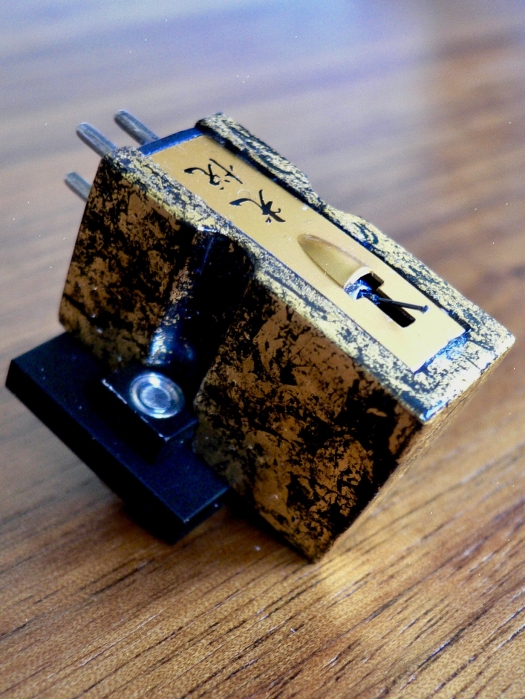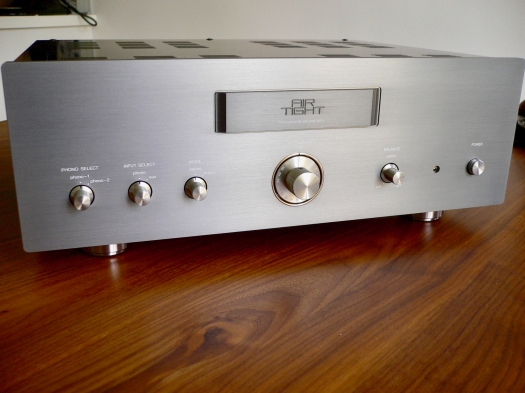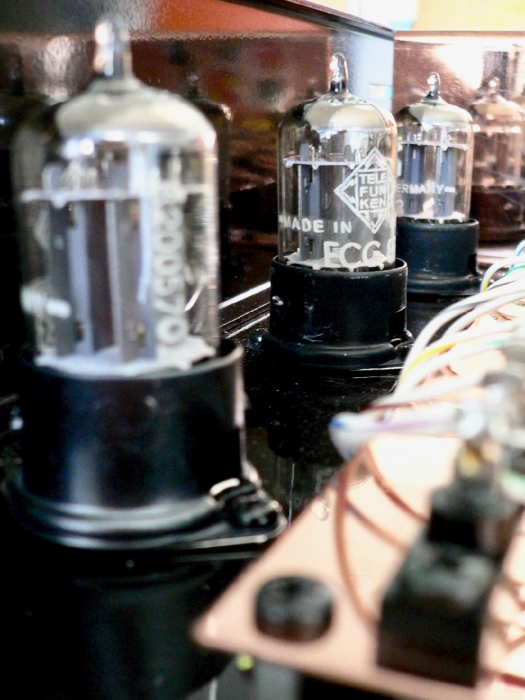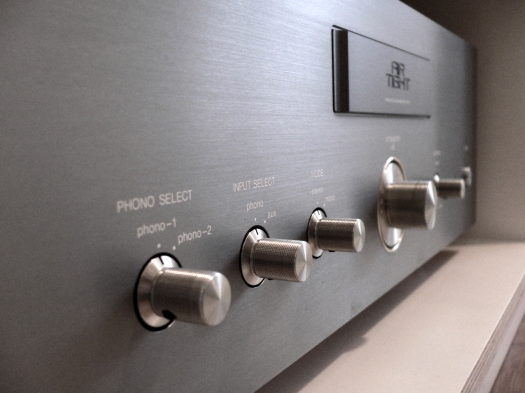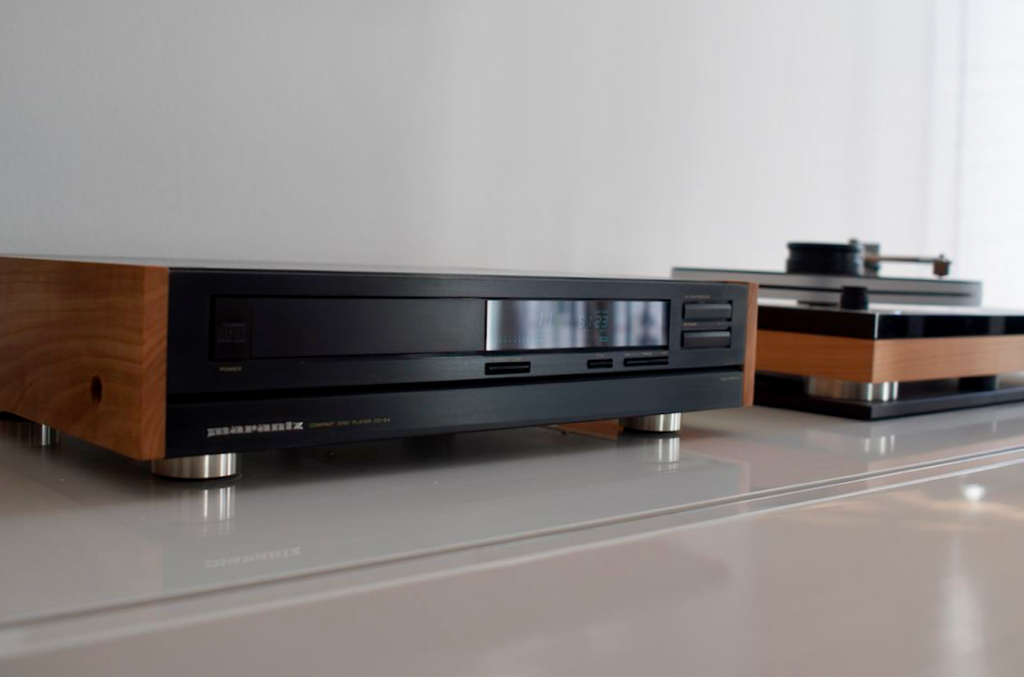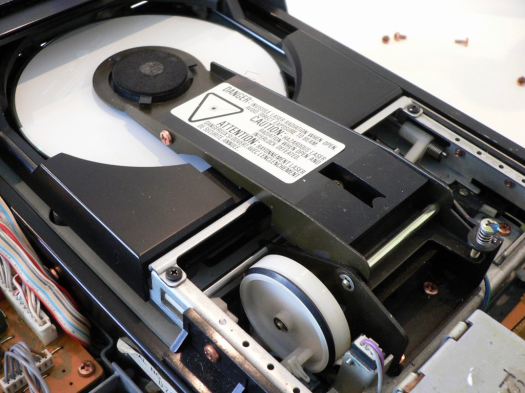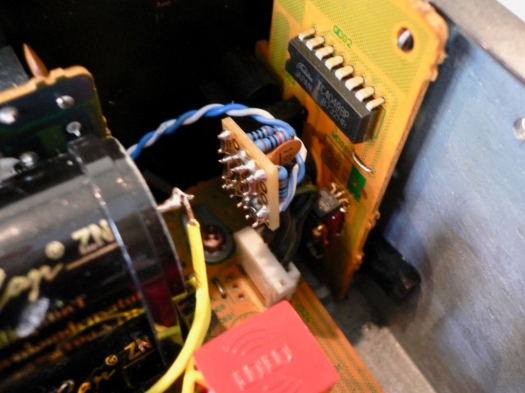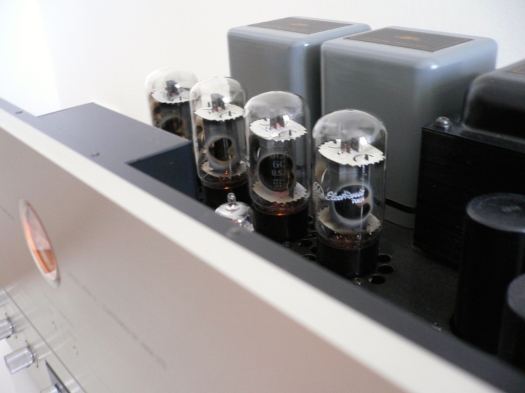In this essay I try my very best to describe the difference of 4 of the most famous Koetsu cartridges, namely the Black Goldline, the Rosewood Signature, as well as the Urushi Wajima and the somewhat special Urushi Vermilion.

The test procedere
All 4 carts were mounted in a Frank Schröder Reference SQ tonearm using two different sorts of headshell plates Frank delivers with his arms to address the different effective mass figures a specific cart needs. More precisely the Koetsu Black Goldline was mounted with the aid of an aluminium plate which delivers with the particular Reference arm a mass figure of 13g. For the Rosewood Signature as also the Koetsu Urushi Wajima I used a brass mounting plate which raises the effective mass to around 18g. The Koetsu Urushi Vermilion got again an aluminium headshell plate, because the whole cart weights a lot more than the two other wood body carts – at the end I could manage to get nearly the same effective mass adjustment as with the other carts.
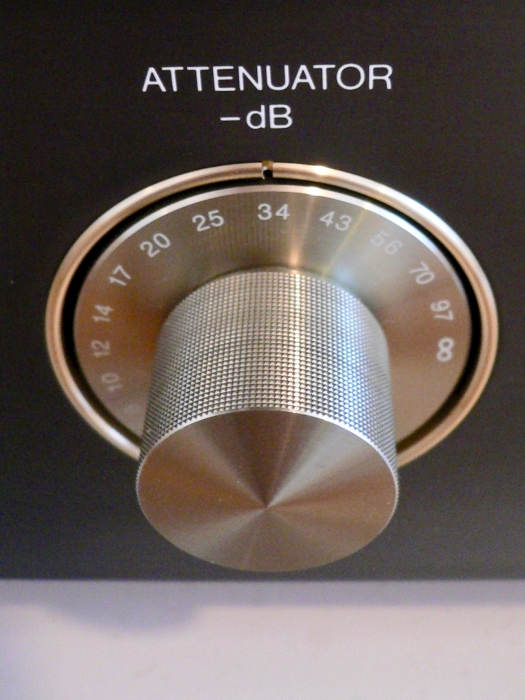
All carts were used with the same table and the same step up transformer. I opted for the Michael Ulbrich “Monster Can” with a 1:20 turn ratio, which let the Koetsu “see” 117 Ohm while getting 26db of clean uncoloured gain! As every cart had a slight variation in output voltage, letting alone the Urushi Vermilion, which delivers just half of what the others offer, I had to adjust the volume accordingly. Finally I recorded each cart with specific music examples using a 24bit/96Khz hard disc recording workstation (Pro Tools) which made adjusting for the exact same gain value an easy task. All carts were used with the the Air Tight ATE2 phono stage (read my essay to that specific type of equipment) and were judged using my beloved Quad ESL 57 as also a pair of original Chartwell 1 (restored vintage speakers) LS3/5a 15 Ohm models. During the test sessions I used also my headphone system (Grado) which hides any coloration from the room acoustics.

I discovered, that Sugano Sans designs needed all their specific, precise adjustments – the SRA (stylus rake angle) differs slightly between the different carts – it is just a tiny bit – but you have to adjust the VTA accordingly. The Koetsu Black showed its best performance with a VTF just a tad under 2g, while the Rosewood Signature sounded best with 1,95g. Both Urushi models liked an even smaller amount of downforce, were the optimum was found around 1,9g. If the VTF is too high all 4 Koetsus sounded dynamically compressed which also resulted in a restricted bass performance with reduced tonal content. Please do not adjust the VTF with the “help” of a test record – you will end up with a way too high amount of VTF! The same must be said for adjusting the antiskating – all four carts needed just a tiny bit of scating compensation to show a perfect tracking performance. Keep in mind that a deflected cantilever is the last thing we want to have – phase coherence and sound balance will suffer seriously, not to speak about the rubber suspension, which will give up one day – than the expensive cart is ready for a trip to Japan….

One side note…..such a serious comparison is not done during one day, nor in two days, it needed 12days in total. Without the possibility to record the soundperformance of each cart, you are easily fooled, because hearing has a lot to do with your mood during listening sessions…Also the human ear can adapt in a few seconds to something new – even if that “New” sounds wrong – after a couple of minutes we think – oh – it is not too bad…..our brain will do the trick – and we wonder, that we get tired while listening to our favourite music. It needs time to dial in a cart to perfection, a quick and dirty adjustment is done in 15minutes – but to get the most out of the stuff it needs more music, more time and two good ears….
The Koetsu Black Goldline

The Black is one of the best selling cartridges of the world – it has a tremendous amount of followers as also people who hate it – it is a very controversial discussed cart, which was a few years ago a good entry into the world of Koetsu. I use intentionally the past tense – because the price of the Black raised from €1600,- 10 years ago (which was a fantastic price performance ratio) – to €1800,- and now we face a price tag of around €2100 – 2500,-. And there is no upgraded technology, no bells and whistles – it is still the same Black Goldline we could buy 10 years ago. Please calculate inflation and all that stuff, and you will never – NEVER come out with an increasement of €900,- in 10 years….. I do not know were this price politic will end – one thing is presumably – with a price tag of €2500,- for the Koetsu Black it is questionable if this cart will continue to be the best selling cart in its class. I mean a Lyra Delos costs in Germany €1300,- and a Kleos under €3000,- so you have the chance to put €500,- on top and get a Kleos – or you save €1200,- and get the amazing Lyra Delos, which is a bargain in my book !
Lets stop that kind of discussion, and start to listen to the little black gem. The Goldline is a sort of sassy Koetsu sound if you compare it with the Rosewood Signature. You get a very sexy up front gesture, a vocal performance which makes you think the singer is right in front of you. A trick managed with a very strong centerfill were the stage is more intimately rendered than big and great. If you listen to Vocal Jazz it could be the last cart you will ever need…..it is in a special way spectacular. That said things change dramatical if you listen to big orchestra compositions. On Mahlers first symphony, third movement (DECCA) you will notice a strong emphasis on the lower mids and upper bass, as also a bump at the lower presence (which makes the vocals so damn sexy). The stage is not illuminated in the way I am used to it, instead of the great size of the orchestra and the recorded space, you get the feeling of a somewhat larger Jazz club. Also the demanding passages towards the end of the third movement is not an exercise the Black Goldline likes too much – it sounds strained and unorganised. If you change your music selection towards Mozart or Hayden – the picture changes dramatically, still there is the uneven frequency response, but in this case you get a warm, sensational string tone with an amazing melodiousness – it sounds soooo real – but it is not. Which brings us to a basic discussion about what is the approach of a HiFi system…is it to be neutral to the source or is it something which can make us believe that what we here is real – even if non linear distortion in any kind is involved??

The Koetsu range of carts showed me, that both philosophies could work – not with every type of music, but in some cases the outcome was spectacular! The Black is not the right cart for heavy metal, it does not like modern classic and also no big romantic orchestra music – what it does amazingly good are smaller ensembles, singer songwriter, Jazz and especially vocal Jazz, Wiener classic and also baroque music…. We get an intimate, holistic picture with a very strong centerfill, a damn sexy vocal performance as also a warm maybe overly ripe lower midrange, which is contrasted by the fresh also emphasised upper midrange / lower presence – so you have to listen carefully….The gestalt of the presence reminds me a little bit of the DL103 which also colours this particular frequency region to minimise the distance between the singer and the listener. The micro dynamic shades the Black has to offer are very very nicely rendered – the incredible silent tracking performance might be the key to this astonishing performance. With the big dynamic swings it is a different situation – if you compare the Black with a SPU Classic, you will be aware of how big dynamic swings could sound like….and even a SPU is not the last word in this particular discipline.
If you are a listener who scores the beauty of the tone over everything else and you are not interested in romantic orchestra music nor heavy metal – this is it!….if – and this is a big IF – there would be the same price tag as a couple of years ago…I would advice you – buy it – hurry up and get one because you are in for something really special. But for €2500,- there should be a performance which is completely independent of music styles and orchestra sizes….
The Koetsu Rosewood Signature

Listening to the Rosewood Signature, we are diving into Sugano Sans world in all its glory – it is in my opinion the first real Koetsu cart. And as I wrote in part I of this essay – it is a very steep price tag we have to pay for this experience. The Koetsu Rosewood Signature is cut from another cloth than the Black Goldline. The first thing you will notice is the amazing amount of recorded space, the width of the stage with the exactly rendered sound sources placed on it. The bass has a grown up gestalt, it is still not the sinewy delicate and amazingly fast bass of a top notch Lyra cart – but it is aesthetically fantastic. Full bodied with endless shades of colour and heft. The midsection is world class – I know nothing that can beat a Koetsu in this discepline – again millions of colours which wrap around the listener. There is a very stable center fill – but the amount of the upfront gesture is decreased. Still there is a very intimate contact to the things which are located in the center of the stage, be it a trumpet, saxophone or the still very sexy vocal performance. But the scale is now more real – there is someone standing in front of you with a 3d gestalt and it is a human being – nearly in full size – well done Koetsu!!!
The presence emphasis is hardly detectable anymore – but it is there – a tiny, tiny bit of it enables the Rosewood Signature to produce a string tone you will never forget. The Rosewood Signature has a complete grain free treble section, a very, very smooth performance, you get a good dose of that magic sparcle without any analytical touch, it is enough treble energy to make the whole sound very balanced. Everything is so masterfully voiced, that you do not be aware of all the tiny anomalies which differentiate the Rosewood Signature from the total neutral Lyra carts (Lyra is just an example – you can also use Air Tight, My Sonic Lab or Transfiguration).

The big dynamic swings are no problem for the Rosewood – it can follow even the most demanding passages with great ease, The Rosewood still favours of the release,of a given tone over its leading edge. The cart is more about the beauty of the tone than the birth of the latter. It shows a tremendous color palette – and the sheer excitement of the music. The micro dynamic redering is amazingly well displayed, again it might be the fantastic silent ride the cart is able to achieve which results is a very, good signal to noise ratio that makes it easy for us to detect all the tiny details in the music. I would call this a totally unforced kind of resolution which does not need a shift in the treble or air region. The Rosewood performs naturally and with a wholeness which puts the gestalt of any composition in front of its molecular structure. The rhythmical performance is voiced in a special sway, which gives you a clear perspective of the groove in the music but at the same time you get this magical flow, which seems to be able to show you to any given time the most important part of the music. That makes the listening experience very easy and relaxed – even with demanding or complex music.
The Rosewood Signature is all about the Koetsu magic – nothing more and nothing less!
The Ursuhi Wajima

The Wajima has a lot of what the Rosewood already brought to the table – but you get nearly in every criteria more… more tightness in the bass, more neutrality in the whole spectrum, a lot more dynamic resolution, and also much more smooth treble. Is it the silver cladded coil wire or is it the Urushi lacquer – or maybe both – but to which degree??? – I cannot tell you – because the Koetsu portfolio avoids a direct comparison of just one of the parameters. It is astonishing in which way those two ingrediences shift the sound performance to a whole new level. The miracle of the Wajimas voicing lays in its ability to show all the beauty the Rosewood is capable of – but garnished with all the High End bells and whistles. If you compare both of these gems, yo will easily detect the increased resolution – and this is not a little bit more, it is a whole new chapter. Sugano San managed to show us all that without loosing the holistic gestalt. The treble and air section is something, nobody would expect from a wood body Koetsu – airy and open, free from any colouration and very, very smooth and grainless. The treble is able to give us a tree dimensional touch, which makes cymbals and a snare drum not a flat event, instead of that, we feel a dimensional corpus sending its sound waves towards us. The bass is also different – gone is the mid bass emphasis, instead of it we get now a deep and fast bass performance which is still very, very colourful and rich in its tonal gestalt. But it acts in a faster fashion, so that the Urushi Wajima does not anymore evaluate melody over rhythmical structures – both is shown in a wonderful balanced performance. The leading edge gets more attention, while at the same time it is not decreasing the ability to render the release of a tone till it is vanished in silence. Amazing!!!! The stage is wide open – as a window and we can see all the details from the far extremes left and right towards the center as also an amazing view into the third dimension. Centerfill is traditionally a Koetsu strength – the Urushi makes no exception here, but the center section is so very well integrated into the whole stage, that I would call it a perfect rendering. What some people will miss is the sexy up front vocal performance – and yes – this is one of the reasons why hard core devotees own more than ONE Koetsu….
The Urushi Wajima leaves the fun segment of the Koetsu line up – we are now accommodated in the adult section….(not what you think….) It is a precise tool, a complete cartridge and beyond this, it is able to give you all the magic a Koetsu is so well known for.

In my book the Koetsu Urushi carts are the pinnacle of what Koetsu is all about – not ignoring, that a stone body cart might even be a better performer – but this is a complete different chapter which detaches some of the typical sound attributes from this legendary brand.
The Koetsu Urushi Vermilion

If you opt for this special version of an Urushi cart, you must own a phono stage with a lot of clean gain. If you use a tubed phono stage it has to be one of the high gain models, because if you try to compensate the low 0,2mV output voltage with a higher turn ratio of a step up transformer (1:30 or even higher) you will dampen the cart more heavily. With a 1:20 the cart “sees” 117 Ohm, with a 1:30 SUT the cart will be dampened with 59 Ohm – which will kill most of what the Vermilion is about. Sugano San constructed the cart with a single layer coil structure to reduce the moving mass, so the Vermilion is able to render the leading edge in a different style than the other wood body Koetsu carts will do. And this is the first thing you might detect – the Vermilion is constructed to give us a growth in speed and attack rendition. It is maybe the first Koetsu in the line up which shows the rhythmical aspects in the music with a tremendous accuracy. The miracle is – you loose nothing of the ability to render the beauty of the tone – it is like driving a Mercedes S Class but with a motor designed by Porsche…..I love it!!!! It is like squaring a circle what Sugano San achieved with the Vermilion – chapeau! If you can use a 1:20 Step Up device with a high gain tubed phono section, without any noise, it is like a miracle. All the characteristics of the Urishi Wajima are now paired with a tremendous rhythmical precision. The bass has somewhat more impact and the treble and air are more pronounced – again without the tiniest amount of grain or harshness, this little red devil is sooo smooth – but it shows you an impressive resolution. Mybe it is the first Koetsu in the portfolio which is able to render heavy metal music at its best – there is no stress even in the most compressed wall of sound sections of such music, a full distorted electric guitar sounds amazingly real, as also the lower end of the frequency spectrum punches in our stomach and we will have a big smile on our face. That said – the Vermilion is also a statement in rendering big orchestral work – even the most complex passages are performed in a casual fashion, that is on par with the best carts you can buy.

The Vermilion is in its special way the most unlimited Koetsu cart of the wood body family – and yes – I do not think that the Platinum Signature does it in a better way – it is just a little bit different. My advice is to get the platinum magnet structure with the stone body carts – this is a suit which fits perfectly. The wood body range has its pinnacle performance in the creation of the Urushi cartridges and something very special can be found with the Vermilion.
Thank you Sugano San for all the great music!
stay tuned
E. Strauss



















